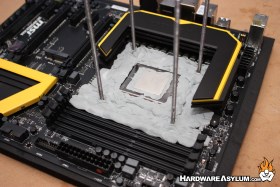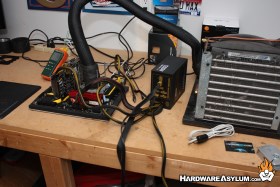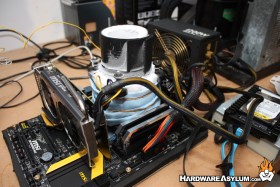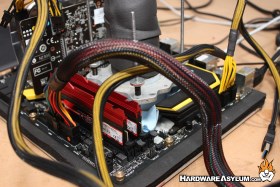MSI Z87 MPower Max Overclocking Impressions
Author: Dennis Garcia
Published: Monday, August 05, 2013
Overclocking Impressions
The MOA 2013 Semi Final was a little different from the Qualifier in that the hardware limitations were more specific with a few clarifications solidifying what MSI was expecting to see. All the hardware had to be MSI branded with competitive video cards starting with the GTX Titan down to any version of Lightning card you had available. The motherboard needed to be based on the LGA 1150 and lucky for me I had a brand new Z87 MPower Max at my disposal.
Customary for my overclocking style I prepped the motherboard for subzero cooling with kneaded eraser and blue shop towels. The insulation process is pretty straight forward. I start by sealing around the processor and move outwards covering the entire PCB surrounding the CPU socket stopping at the PWM and memory slots. Under Single Stage you can get away with less eraser and more shop towels but with LN2 you need consider that the cold travels. As a precaution I seal up the first memory socket nearest the CPU with eraser and make sure the base of the PWM is sealed.
Customary for my overclocking style I prepped the motherboard for subzero cooling with kneaded eraser and blue shop towels. The insulation process is pretty straight forward. I start by sealing around the processor and move outwards covering the entire PCB surrounding the CPU socket stopping at the PWM and memory slots. Under Single Stage you can get away with less eraser and more shop towels but with LN2 you need consider that the cold travels. As a precaution I seal up the first memory socket nearest the CPU with eraser and make sure the base of the PWM is sealed.
Lastly, four folded over towels flank the socket to catch any water leaking down the side of the CPU container or phase head. This isn't a big deal while things are cold since all of the water will be frozen but after you are done overclocking the moisture needs to be accounted for.
I normally start out with the processor under my Single Stage Phase chiller so I can get a feel for how the system will react under cold without wasting any LN2. Once I have the system configured (both hardware and software) I remove the phase head and attach my favorite LN2 container.
I normally start out with the processor under my Single Stage Phase chiller so I can get a feel for how the system will react under cold without wasting any LN2. Once I have the system configured (both hardware and software) I remove the phase head and attach my favorite LN2 container.
For the MOA competition I spent a total of 6 hours benching and started with SuperPi 32m. Considering that SuperPi is a memory and processor benchmark the key here is to find the best efficiency for your particular overclock and memory combination. Combine this with a few OS level tweaks and you'll have a score. SuperPi is one of my weakest benchmarks so after a few runs I moved on.
The next benchmark was Cinebench and is designed to test multi threaded CPU performance. Memory speed isn't as important with this benchmark but, as with any program having more memory bandwidth helps and many of my SuperPi settings carried over quite well.
The final benchmark in the MOA 2013 Semi Finals was 3DMark Firestrike Extreme. Firestrike is a pure DirectX 11 benchmark that is heavily weighted on overall GPU performance and is where anyone with a good GTX Titan card will easily walk away with the top prize. HWBot/MSI also offers the most points for a good score in this benchmark so it's important to score well. Sadly, I didn't have a GTX Titan and my Radeon HD7970 Lightning wasn't going to be competitive so I settled on overclocking a MSI GTX 650 Ti Boost and walked away with a gold cup in the category.
This goes to show that you don't have to have the latest and greatest hardware to enjoy overclocking and having a solid motherboard platform is key to the success of your endeavors.
The final benchmark in the MOA 2013 Semi Finals was 3DMark Firestrike Extreme. Firestrike is a pure DirectX 11 benchmark that is heavily weighted on overall GPU performance and is where anyone with a good GTX Titan card will easily walk away with the top prize. HWBot/MSI also offers the most points for a good score in this benchmark so it's important to score well. Sadly, I didn't have a GTX Titan and my Radeon HD7970 Lightning wasn't going to be competitive so I settled on overclocking a MSI GTX 650 Ti Boost and walked away with a gold cup in the category.
This goes to show that you don't have to have the latest and greatest hardware to enjoy overclocking and having a solid motherboard platform is key to the success of your endeavors.







